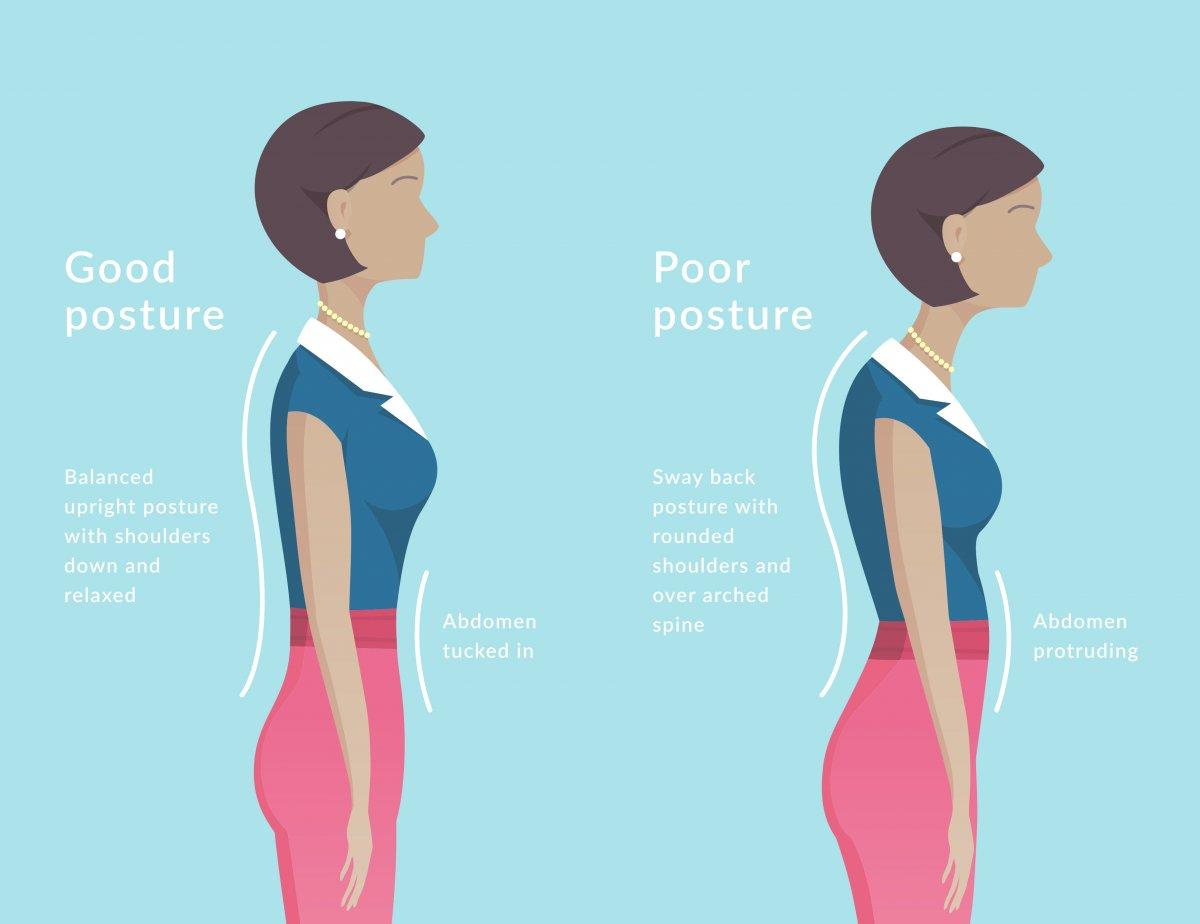Posture can affect many different parts of your life, especially if you’re using your body to learn how to sing, play an instrument, or exercise. Learn more in this article by New York teacher Nadia B...
Perhaps you’ve been told by a friend or family member to stop slouching and stand up straight, in hopes of improving your posture. But what if we told you that even if you did just that, it wouldn’t necessarily fix your posture?
It may come as a surprise to learn that standing up straight is not enough to guarantee good posture — nor is it an overnight solution.
In this blog post, we’ll discuss why standing up straight won’t fix your posture and look at some other options for correcting alignment issues.
Can You Reset Your Posture?
It’s no secret that bad posture can cause a variety of physical problems and contribute to mental strain, but it can be difficult to know where to even begin when attempting to reset your posture. Fortunately, there are some simple tips you can use if you’re wondering how to fix your posture at home:
- Be aware of your surroundings and how they may affect your posture. For example, if you tend to hunch over while sitting at a desk all day, consider investing in an ergonomic chair or standing desk.
- Do stretching exercises regularly as they help relax tight muscles and rebuild strength that has been weakened by poor posture habits.
- Finally, make sure you get enough rest — maintaining good posture requires energy and staying well-rested helps support the effort.
Using these steps will help you break old habits and establish healthier postural patterns for greater physical wellbeing!
Still curious about the best way to fix your posture? In many cases, it makes the most sense to get some professional help! If you’re not already taking acting, singing, dancing (or whatever else you might be interested in!) lessons, it’s time to start. Sign up now to get expert advice and tips – and access to helpful resources like the video you see below:
https://www.youtube.com/watch?v=F35UkNPC1jw
The Best Way to Fix Your Posture Isn’t Standing Up Straight – Here’s Why
Are you slumped over your computer or phone as you read this? Bad posture can lower our self-esteem, send a message of disinterest or incompetence to the outside world, and cause a great deal of strain, fatigue, and pain. Conversely, an upright and poised posture can boost our self-image, reflect an attitude of interest and engagement and create a sense of lightness and ease within our bodies and minds. While an aligned posture can enhance and support your well-being and reduce aches and pains, poor posture can lead to a variety of ailments. Posture can also be important in a variety of contexts, such as playing a musical instrument, where your body plays an integral role in your expressive capabilities. Read on to discover how to fix your posture with some simple, practical tips.
What’s the Secret to Fixing Your Posture?
The biggest misconception about posture is that a rigid, vertically straight position is the best way to avoid slumping and maintain a good stance. Actually, when we pull our shoulders back and over-straighten the spine, we are creating another layer of tension. The best posture is one that is easily upright, allows you to breathe without constriction and engages the musculature of the core including the front and back (not just the abdominal muscles) in an integrated way. So, the first step in fixing poor posture is to let go of the idea that good posture is a challenging, military-style pose to maintain. This also means letting go of the idea that your back should be straight. Our spines have natural curves that help to absorb impact, and, while it’s not necessary to over-exaggerate the natural curves of the spine, recognizing that the curves exist can allow you to let go of habits of over-straightening the spine.
Pay Attention to Your Support
Now that you have an idea of what you do and don’t want, learning how to fix your posture begins with noticing your points of support and contact as you move throughout the day. When we are standing, our bodies are supported by the ground. Instead of holding yourself up away from the ground, which leads to excess tension and effort, you can allow your weight to release into the ground. Just noticing that your feet are making contact with the ground is a simple and effective way to start to make use of its support. Likewise, when you are sitting, you can notice your sitz bones (two bony structures that you can feel underneath your seat if you rock sideways in your chair) releasing into the chair and allow your body weight to be supported by this contact. These tips are especially relevant if you tend to slump rather than hold yourself up rigidly.
Visualize Your Energy
Once you are aware of your points of support, the next step is to understand that we are inherently built to grow upwards, away from the ground. Just like trees, we are ideally releasing our roots (body weight) into the ground while the trunk of the tree and the branches (the body itself) grow up and out, away from the ground. Sensing the contact with the ground while visualizing the energy releasing up the spine and out the head can give you a sense of this relationship that is always ideally occurring when excess tension is eliminated.
Perhaps the least-known but most crucial concept about posture is that good posture should help you to breathe more easily. The military-like stance mentioned earlier causes excess tension that prohibits the breathing mechanism (the ribs, diaphragm, and spine) from free and easy movement, while slumping also takes away room and freedom for movement by compressing the torso and spine. So a good tip about posture is that if you find yourself with more internal room to breathe and it feels easier to breathe, that’s probably a better posture than one in which you find yourself struggling to allow the ribs to move or where breathing requires a lot of effort. Noticing how you are breathing also requires awareness. While developing awareness may require some initial effort, taking a few moments throughout the day to notice your posture and your breathing will in the end lower the risk of injury, enhance performance, and foster a sense of well-being and tranquility.
Following these steps will help you to fix your posture, whether you struggle with a specific problem like back pain at the computer or want to refine a specific skill that requires a high level of coordination, like playing a musical instrument or running.
How Can I Realign My Posture?
Still curious about how to fix your posture? Here are a few more tips.
How to Fix Your Back Posture
Maintaining good back posture should always be a priority if you want to stay healthy and live an active lifestyle. Unfortunately, poor habits make this easier said than done.
The good news is that you can improve your posture and fix bad habits by making small changes to your everyday routine.
Be conscious of your body’s positioning when sitting and standing, engage in regular stretching exercises for the neck, shoulders, and spine, practice mindful breathing techniques to help relax tight muscles that can pull you into poor posture positions, take frequent breaks between seated activities so your circulation stays active, and most importantly- make sure you are using the correct chair and desk combination for proper ergonomic support.
How to Fix Your Neck Posture
If you are sitting at a desk for long periods of time or want to fix your posture, improving your neck posture should be at the top of your list. Bad neck posture usually occurs when slouching or looking down at our phones and computers all day. In order to get rid of this habit, it is important to pay attention to how your head is in line with your body.
Practicing neck exercises can help reduce tension in the neck and upper back muscles that can cause pain. It is best to do these exercises little by little throughout the day as opposed to stressing yourself out doing them all at once.
Other helpful tips include paying attention to your seating position or raising any computer screens higher so they are not blocking your view. Improving your neck posture can give you greater range of motion, help get rid of headaches and soreness, and leave you feeling much better overall.
How to Fix Your Posture While Sitting
Poor posture while sitting can cause a multitude of health issues, from back strain to poor breathing. To help fix your posture while you’re sitting, make sure that your back is straight and your feet are flat on the ground so that your thighs are parallel to the floor. Adjust the height of your chair so that when seated at the edge, your legs make a 90 degree angle from your hips.
Check to see if elbows are bent at 90 degrees too, with wrists in line with the arms and shoulders relaxed; adjust the armrests accordingly or scrap them altogether if not in use.
Finally, be mindful of any bad postural habits you have and strive to sit differently; put a cushion behind you for lumbar support if needed or practice switching between sitting and standing for better posture awareness.
How Long Does it Take to Fix Posture?
So how long does it take to fix your posture? The short answer is…it depends.
Improving posture through exercise and conscious body positioning can be an incredibly rewarding process; however, it does require commitment to long term effort.
On the upside, many of the stretches and exercises you need to improve your back and core strength are easy to do anywhere and require no special equipment. Depending on your starting level and the amount of time you devote each week to improving posture, you may find yourself making meaningful progress within a month or two.
Taking a holistic approach that includes stretching, yoga practices like downward dog, exercise shrugs or telescopic planks can help realign both your abdominal ache muscles as well as those in your upper back, shoulders and neck to achieve improved posture.
Remember, your posture is a reflection of your thoughts, emotions, and overall health. If you want to improve your posture, start by working on your mental and emotional health. Address any unresolved trauma, release muscular tension, and practice self-care.
Strengthening your muscles will also help improve your posture in the long run. So, if you’re looking to fix your posture, start from the inside out – and follow the advice we’ve given you in this article. Good luck!
 Nadia B. teaches fitness, flute, and piano lessons in New York, NY, as well as through online lessons. She acted as principal flutist of the orchestra and wind ensemble at California State University, Sacramento, and then went on to receive her degree in Music Performance from New York University. Learn more about Nadia here!
Nadia B. teaches fitness, flute, and piano lessons in New York, NY, as well as through online lessons. She acted as principal flutist of the orchestra and wind ensemble at California State University, Sacramento, and then went on to receive her degree in Music Performance from New York University. Learn more about Nadia here!
 Photo by See-ming Lee
Photo by See-ming Lee
Suzy S.
